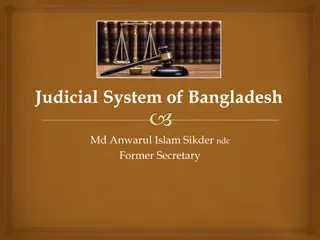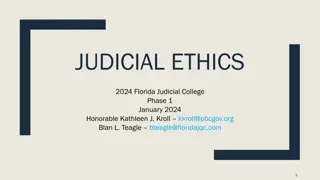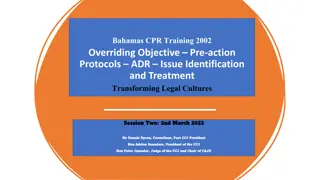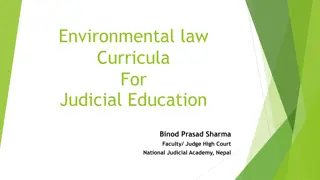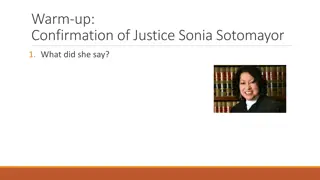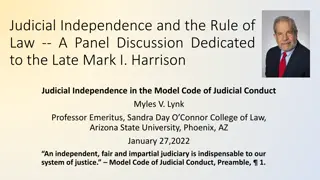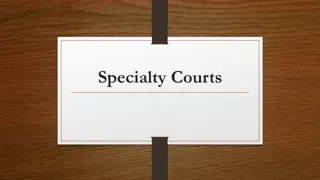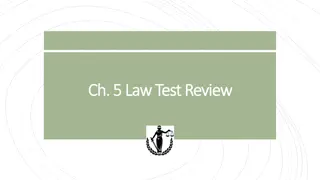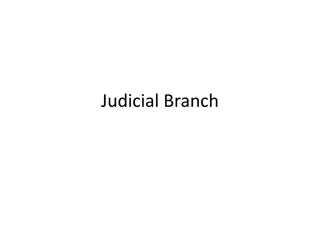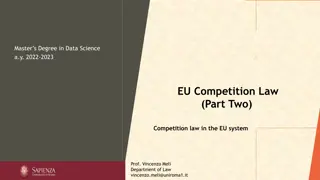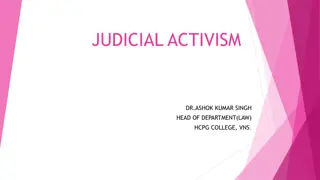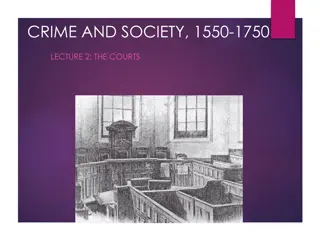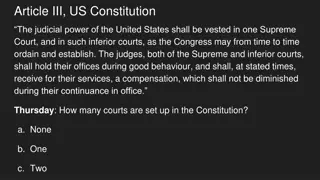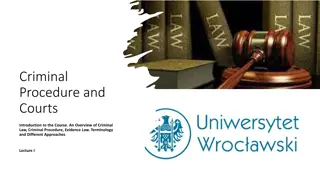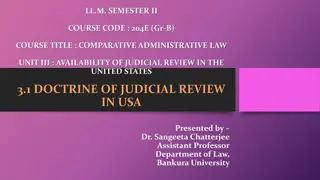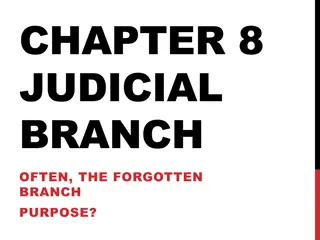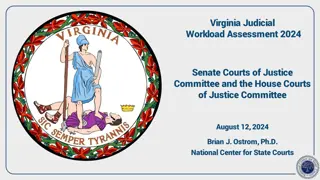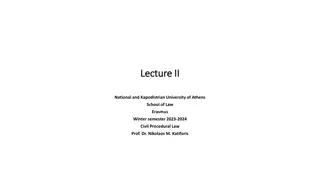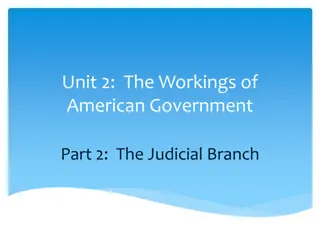Role of Supreme Courts in Ensuring Effective Judicial Systems in the European Union
This communication focuses on the vital role of Supreme Courts in guaranteeing the effectiveness of judicial systems within the European Union. It delves into the significance of courts' communication strategies, emphasizing accessibility of justice, trust-building, and public image. The discussion explores the importance of active communication, target audiences, communication content, and various communication mediums used by the judiciary. Cautionary principles such as presumption of innocence and judicial dignity are also highlighted.
Download Presentation

Please find below an Image/Link to download the presentation.
The content on the website is provided AS IS for your information and personal use only. It may not be sold, licensed, or shared on other websites without obtaining consent from the author. Download presentation by click this link. If you encounter any issues during the download, it is possible that the publisher has removed the file from their server.
E N D
Presentation Transcript
SUPREME COURTS AS GUARANTEE FOR EFFECTIVENESS OF JUDICIAL SYSTEMS IN THE EUROPEAN UNION Communication by Supreme Courts Prof. Dr. Bernard Hubeau University of Antwerp Law Faculty
Courts and Communication Communication = the act of conveying intended meaning (information) from one person, entity or group to another, through some medium 4
Communication Strategy WHY? TO WHOM? Objective Audience Communication Strategy WHAT? HOW? Message Means 5
Communication: WHY? 1. Accessibility of Justice 2. Acceptance trust 3. Image making trust 6
Active communication: WHY? A decline of specialist journalists and strong competition leads to inaccurate and sensational reports The judiciary should only communicate through its decisions 7
Communication: TO WHOM? Accessibility of Justice (Potential) litigants Broader public Parties Scholarship Broader public Press Acceptance Image making Broader public Press 8
Communication: WHAT? Accessibility of Justice Court rules Procedures Decision Reasons Acceptance Image making Decision and reasons Broader case law 9
Communication: HOW? Medium Tools and Organisation Website Social media Press Audio and video recording in courtrooms Hearings in Parliament Style Book Case law database Year reports Schedules and plans Educational activities Feedback & Complaints procedure Press officers Communication advisors 10
Cautions Presumption of innocence Right to privacy Impartiality of the judges Dignity of the authority of the judiciary 11
Survey 1. WHAT? 2. HOW? Organisation 3. HOW? Methods 4. Cooperation with regard to communication issues 5. Educational activities 6. Expressing judiciary s opinions to parliament and executive 12
1. WHAT? Information content Recommendations: 1. Make publicly available case allocation rules, the agenda of the hearings, results of disciplinary hearings 2. Host a website with general information, events and judgments Extra: guidelines, complaint forms, statistics, interviews, FAQ, summaries, 13
2. HOW? Organisation Recommendations: 1. Establish a press division and designate a judge-spokes- person 2. Provide for media training for the judge-spokesperson 3. Establish a forum to exchange experiences between press judges and communication advisors 4. Provide advice to lower courts that have no specialised press division 14
Survey Results: Creation of a Press Division and Position of the Spokesperson Supreme Court Judge- Non-judge spokesperson Press division Total spokesperson EE x x x 1 AT(Adm), DE, HU, LV, NL, PL , RO x x 7 LT x x 1 CR, FI, PL(Adm), SK, BE x x 5 LT(Adm) x 1 CY, IT, LU, PT(Adm), SI, ES, ES(Adm) 6 Total 10 7 18 15
Training of press judges: Best Practices Annual training by a media consultant, including a day in a national television and radio studio with interview scenarios that are played back and analyzed Media Handbook for Judges (Judicial Executive Board 2012) with guidelines England and Wales: Council of the Judiciary coordinates special training courses for press-judges, including on-camera training (16 judges/y) The Netherlands: 16
3. HOW? Methods and tools Judgments Press releases Website Social media: Use of social media by the judiciary (Reactions to use of social media by the public in the courtroom) Use of social media by judges Press recordings in the courtroom Educational activities Consultations by Executive or Parliament Feedback & Complaints 17
Methods: Recommendations 1. 2. Issue press releases related to important cases, activities, events, etc. Make the press division responsible for the preparation of press releases in close relation with the judge that rendered the decision if the press release concerns a specific case Host a website with general information on the court, more practical information, and press releases If social media are used, deliver a strategy and policy Establish clear guidelines regarding audio and video recording that take into account the different rights at stake Organise round-table discussions with other legal practitioners, educational activities for society, and press briefings to explain the judicial procedure Supreme Courts can make the Executive or Parliament aware of problems through consultations, rulings and annual reports, but should refrain from public policy debates or giving political opinions Conduct specific surveys regarding the working of the Supreme Court in addition to State surveys on the public opinion regarding justice systems Implement a three level complaints system 3. 4. 5. 6. 7. 8. 9. 18
1. Issue press releases related to important cases, activities, events, All courts issue press releases Exception : SC Luxembourg On a broad variety of subjects (events, procedures, cases) Exception: SC Italy: generally not on cases Selection of important cases: that raise important questions of law, or attracted media attention or public interest Exception: SC UK press release for every case 19
2. Make the press division responsible for the preparation of press releases Where a press division is established (17), it usually prepares the press releases, in coordination with the judges invoilved or the President of the Court (12) Selection of important cases: Judge (6): FI, DE(Leipzig), EE, IE, ES, SI, Press division/press judge with judges involved (10): CZ, EE, NL, LU, PL(Adm), HU, SK, AT(Adm), LV, PT Press division (2): PL, LT(Adm) 20
4. If social media are used, deliver a strategy and policy Twitter (CR, NL, LT(Adm)) LinkedIn (CR, SK) You Tube (EE) Facebook (EE, NL, PL, Lt(Adm)) By the judiciary General ethical rules Specific rules: EE, SK, LT, LV Duty to inform the court management No personal views on cases under review By judges 21
5. Recording in the courtroom If the law provides for discretion Establish clear guidelines If recording is permitted, but the court can make an exception: hear the media first In high profile cases: make practical arrangements with the press Best Practices: NL, HU 22
6. Educational activities For legal practitioners (next slide) For society: Guided visits or open days (20 SC) Meetings or public conferences (8 SC) Other: mock trials, shadow days, 23
6. Educational activities: for legal practitioners Court Seminars, conferences Training Meetings and roundtables Total AT(Adm), LU, PT(Adm), ES, SE, SE(Adm) 6 AT, IE, IT x 1 CY, SI x 2 HU x 1 DE, LV, PL, PL(Adm), PT x x 5 NL, RO x x 2 CZ, EE, FI, LT, LT(Adm), BE x x x 6 Total 16 13 9 24
7. Consultations by Executive or Parliament All Supreme Courts, are consulted on proposed laws affecting the judiciary Except SC IE, SC PT Mostly informally, sometimes in a formal way Sometimes involved in parliamentary working groups Communication to Parliament or the Executive Several SC of problems faced with during the adjudication of cases, Several SC are reluctant given the separation of powers (EE, NL, FI, DE, IE, IT, LT(A), RO) Through the High Judiciary Council (PT) or the Supreme Council of the Administrative and Fiscal Courts (PT(Adm)) On an informal basis (CZ, LU, SV, CY, AT(Adm), LT, SI) In annual reports (PL, PL(A), LT, ES) 25
8. Feedback: Conduct specific surveys regarding the working of the Supreme Court Use of surveys and opinion polls to receive and implement feedback on the workings of the court by SC: minority (EE, LT, SL, LV, RO) On the website (LT, RO) More often: in an informal way (FI, DE, HU, LT, LT(A), SK, PT) By other institutions (e.g. Justitiebarometer BE High Council for the Judiciary) The Supreme Court can benefit from additional surveys on the activity of the Supreme Court itself. 26
9. Complaints system The majority of Supreme Courts examines complaints (other than disciplinary proceedings) (CZ, EE, NL, DE, PL, PL(A), HU, LT, LT(A), SK, SE, SE(A), CY, SL, LV). Some more streamlined and formal than others In other systems, complaints are examined by other institutions (IT, ES) 27
9. Implement a 3-level complaint system 2-line complaints handling authority Complaint manager within the SC Zero-line complaints handling desk 28



